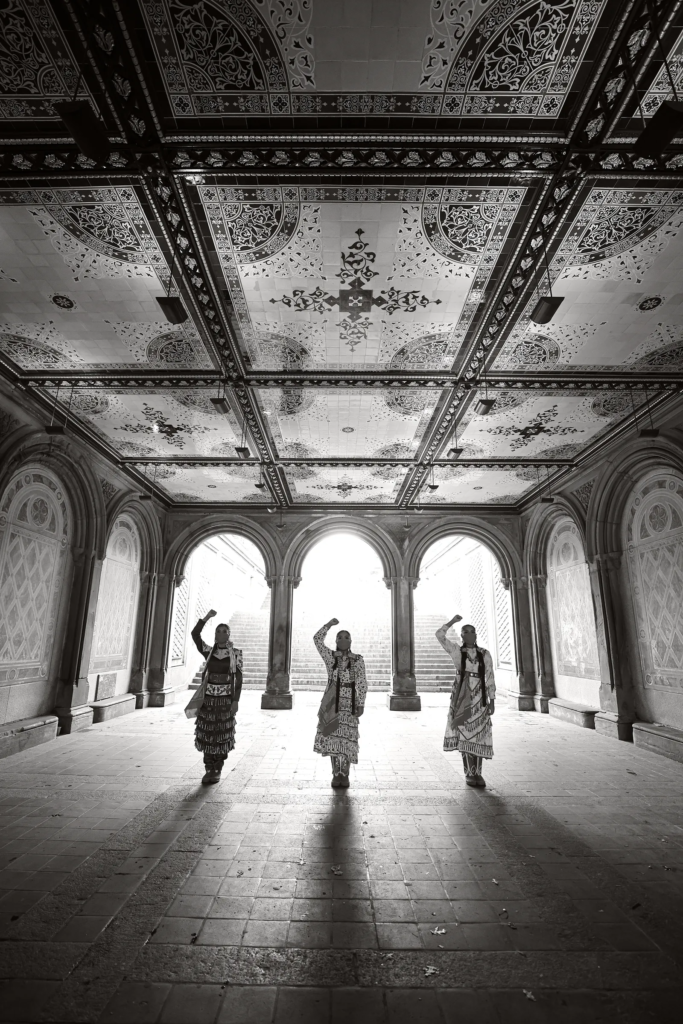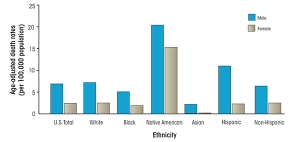As the COVID-19 pandemic began raging across the globe in spring 2020, Navajo photographer Eugene Tapahe had a dream. He was sitting on the grass at Yellowstone National Park (which extends across Wyoming, Montana, and Idaho) and watching bison graze under the setting sun. Suddenly, jingle dress dancers appeared and started performing the traditional Ojibwe healing dance, with the bison slowly joining in. “All of a sudden, I felt like I was at peace,” Tapahe says. “At the time, everything felt hopeless and dismal, and we didn’t really know what was going to happen. But in the dream, I felt a sense of hope and healing.” When he awoke, he wanted to bring that feeling to reality—and to share that feeling of peace with other Indigenous communities suffering too.
And thus, the Jingle Dress Project was born. Tapahe launched the project last year with his two daughters, Erin and Dion Tapahe, and their friends, Sunni and JoAnni Begay, who are also Navajo (the dance is performed by women and Two-Spirit people, and originally derives from the Ojibwe tribe). The four dancers have since been performing the jingle dress dance in various communities across the U.S., with Eugene photographing them along the way. During difficult times, they have been using the dance as a way to uplift communities. “The jingle dress is really important for Native people, and the purposes of healing,” Eugene says. “In our Navajo traditions, we believe that there are four worlds, so each of them represent one of our worlds.” They have brought the dance to 20 national and state parks so far, including Yosemite, Yellowstone, and Central Park—and there’s a specific reason for each one. “When colonization happened, those are the lands that were taken from Native people first,” Tapahe says. “They were plush lands, with food and water.”

One of the first places they visited for the project was the Bonneville Salt Flats in Utah. “When we got there, it was raining and storming,” Tapahe says. “Then, just when we were starting shooting, the clouds cleared, and the sun came over the horizon.” In each location since, the four dancers have continued to perform the dance to a healing honor song recorded by a family friend. “We take that song with us everywhere we go,” Tapahe says. “It feels really spiritual [when the girls dance to it], as though the ancestors that lived there are dancing with the girls.”
While the project offers a sense of healing to Indigenous people who see the dance, it has also evolved to be an opportunity to educate and introduce non-Indigenous people to the artform. One of their favorite stops to date has been New York’s Central Park on New Year’s Eve last year. “There weren’t very many people in the park, but as we started the music and the girls started dancing, the tunnel amplified the sound,” Eugene says. “By the time they were done, there were people all over that had been attracted to the music. It was amazing to know that even non-Native people could feel the healing power of the jingle dress.”

The dresses they wear have been an especially powerful tool to share elements of their culture with others. Traditionally, jingle dress dancers wear regalia adorned with beadwork and ribbon work, as well as triangular metal cones around the skirt, which shake and create a distinctive sound with each step. The dresses are customized for each dancer as well. “My dress is yellow, one of my favorite colors, but my Navajo name is Sháńdíín, which means sunshine, so I chose yellow to reflect the sun,” Dion says. “Usually, jingle dresses have straight rows of jingles, but I really like it when they have an A-frame.” Her sister, Erin, adds, “I wanted my dress to be blue, because of the experience I had at [the] Standing Rock [pipeline protests]. The blue represents water.”

The accessories the four jingle dress dancers wear are also embedded with special meaning. “We wear red scarves with a jingle dress dancer on it, to symbolize missing and murdered Indigenous women,” Dion says. “Every time we go out, we dance in prayer for those who are missing and those who have been impacted.” Where they have worn the striking regalia has told its own story as well. “The jingle dress comes from the Ojibwe people, and we were able to go back to the Mille Lacs Band of Ojibwe [territory], where the jingle dress originates,” says Sunni. “It was a great honor and blessing to be able to dance under the same sky and feel the same land that many Ojibwe people have.”

The project isn’t ending anytime soon, even though COVID-19 rates are now, thankfully, decreasing. Eugene and the four dancers continue to chronicle their travels on Instagram and have been invited to dance in locations such as Canada, Alaska, and Hawaii. “It’s only gotten more popular, and people are responding even more to the project,” Eugene says. He says the best part of it all has been the positive response they’ve been getting from their own community, though. “To be able to hear teenage girls say they are wanting to stop doing drugs and alcohol, so that they can start dancing, or to go back to college—people are calling the girls role models,” he says. “Those are the things that really motivate and make us understand the power of the dress.”




